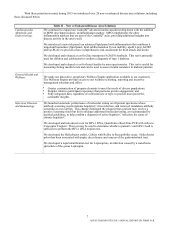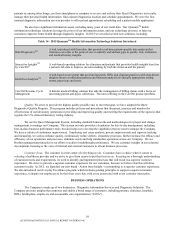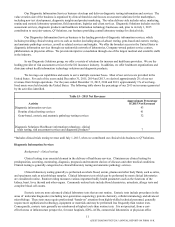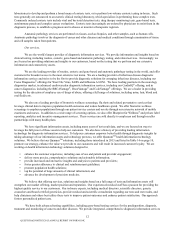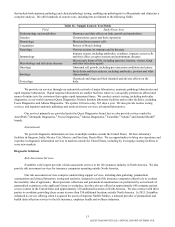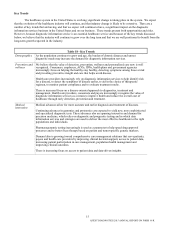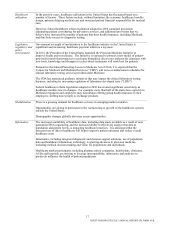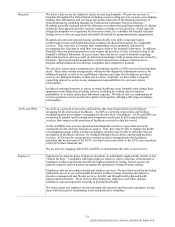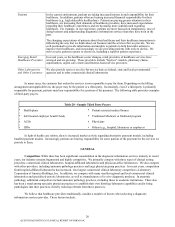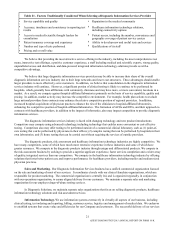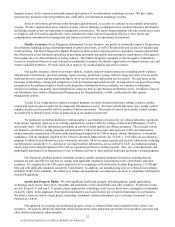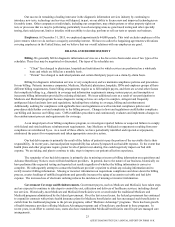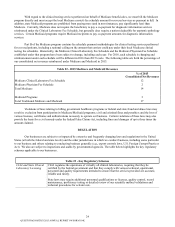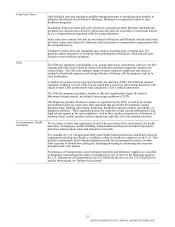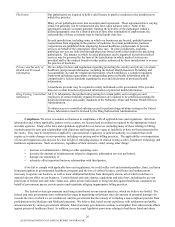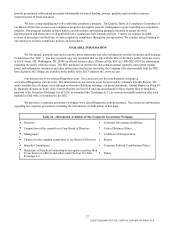Quest Diagnostics 2015 Annual Report Download - page 21
Download and view the complete annual report
Please find page 21 of the 2015 Quest Diagnostics annual report below. You can navigate through the pages in the report by either clicking on the pages listed below, or by using the keyword search tool below to find specific information within the annual report.
17
Healthcare
utilization In the past few years, healthcare utilization in the United States has fluctuated based on a
number of factors. These factors include, without limitation, the economy, healthcare benefits
design, patients delaying medical care and increased patient financial responsibility for medical
care.
However, federal healthcare reform legislation adopted in 2010 contained provisions
eliminating patient cost-sharing for preventive services, and additional provisions that we
believe have increased the number of patients that have health insurance, including Medicaid,
and thus better access to diagnostic testing.
Legislative,
regulatory and
policy
environment
Government oversight of and attention to the healthcare industry in the United States is
significant and increasing; healthcare payment reform is a top issue.
In 2015, the President of the United States launched the Precision Medicine Initiative to
improve health and treat disease. The Initiative is expected to pioneer a new model of patient-
powered research that promises to accelerate biomedical discoveries and provide clinicians with
new tools, knowledge and therapies to select which treatments will work best for patients.
Pursuant to the federal Protecting Access to Medicare Act of 2014, it is expected that the
Centers for Medicare and Medicaid Services (“CMS”) will revise reimbursement schedules for
clinical laboratory testing services provided under Medicare.
The FDA has announced guidance initiatives that may impact the clinical laboratory testing
business, including by increasing regulation of laboratory-developed tests ("LDTs").
Federal healthcare reform legislation adopted in 2010 has created significant uncertainty as
healthcare markets react to changes. For example, more than half of the states have opted in to
Medicaid expansion and employers may discontinue offering group health insurance to their
employees, shifting more people to exchange products.
Globalization There is a growing demand for healthcare services in emerging market countries.
Opportunities are arising to participate in the restructuring or growth of the healthcare systems
outside the United States.
Demographic changes globally also may create opportunities.
Informatics The increased availability of healthcare data, including data made available as a result of next
generation DNA sequencing, and the increased ability to effectively analyze that data at
population and patient levels, is impacting healthcare practices. It is anticipated that the
increased use of data in healthcare will help to improve patient outcomes and reduce overall
healthcare costs.
Informatics, including integrated diagnostic and decision support solutions, use of population
data and healthcare information technology, is spurring advances in precision medicine,
including medical decision making and value, for populations and individuals.
Healthcare market participants, including pharmaceutical companies, health plans, clinicians,
ACOs and hospitals, are striving to leverage interoperability, informatics and analytics to
positively influence the health of patient populations.
QUEST DIAGNOSTICS 2015 ANNUAL REPORT ON FORM 10-K


